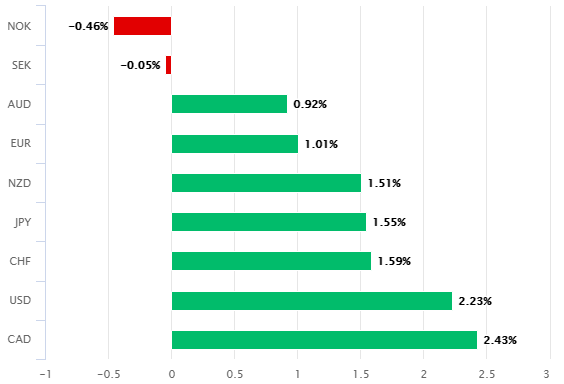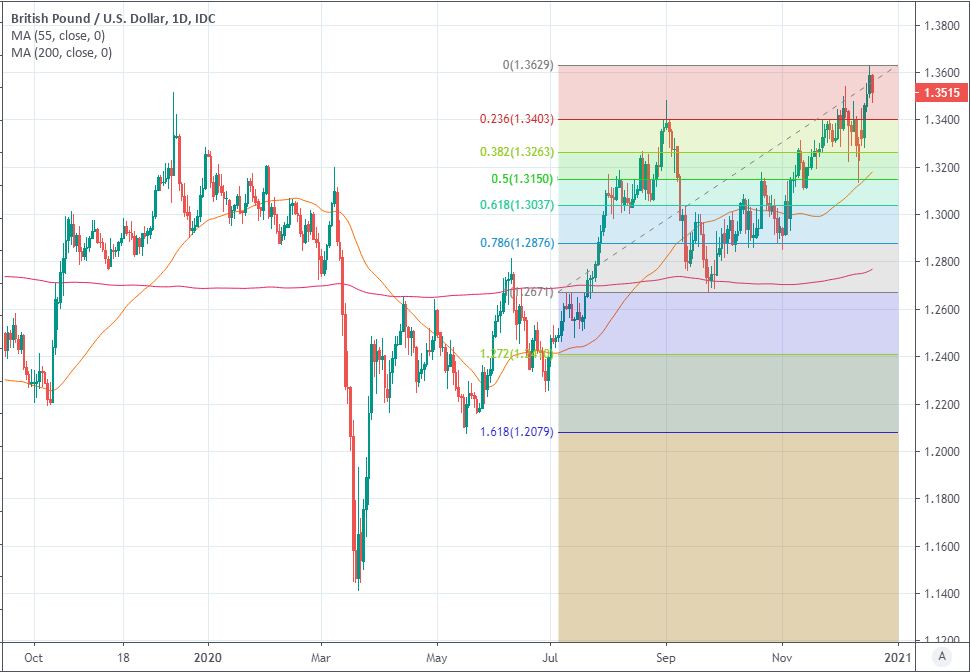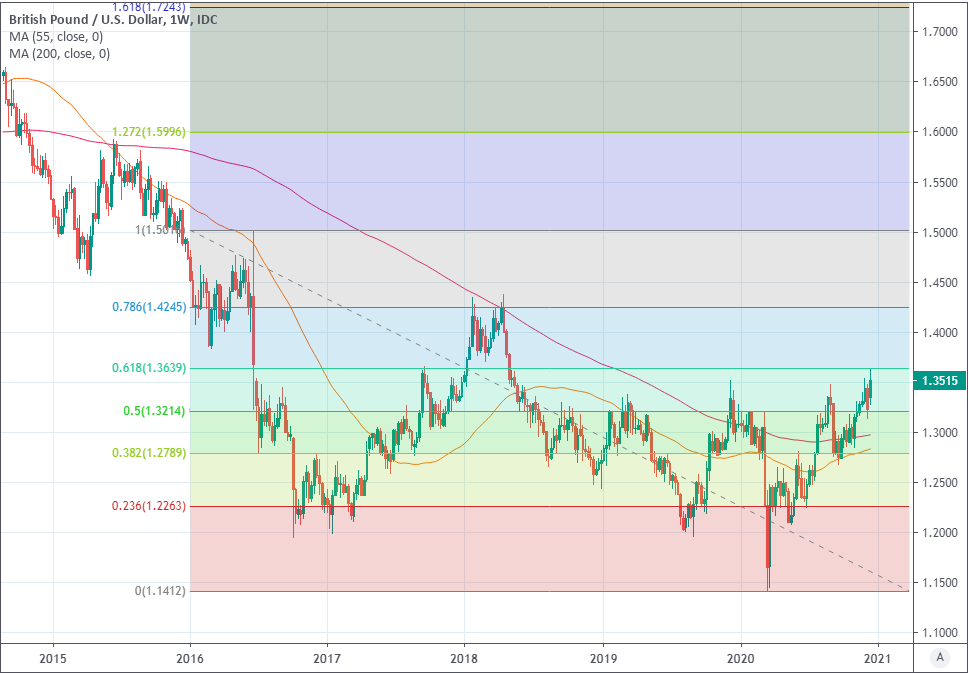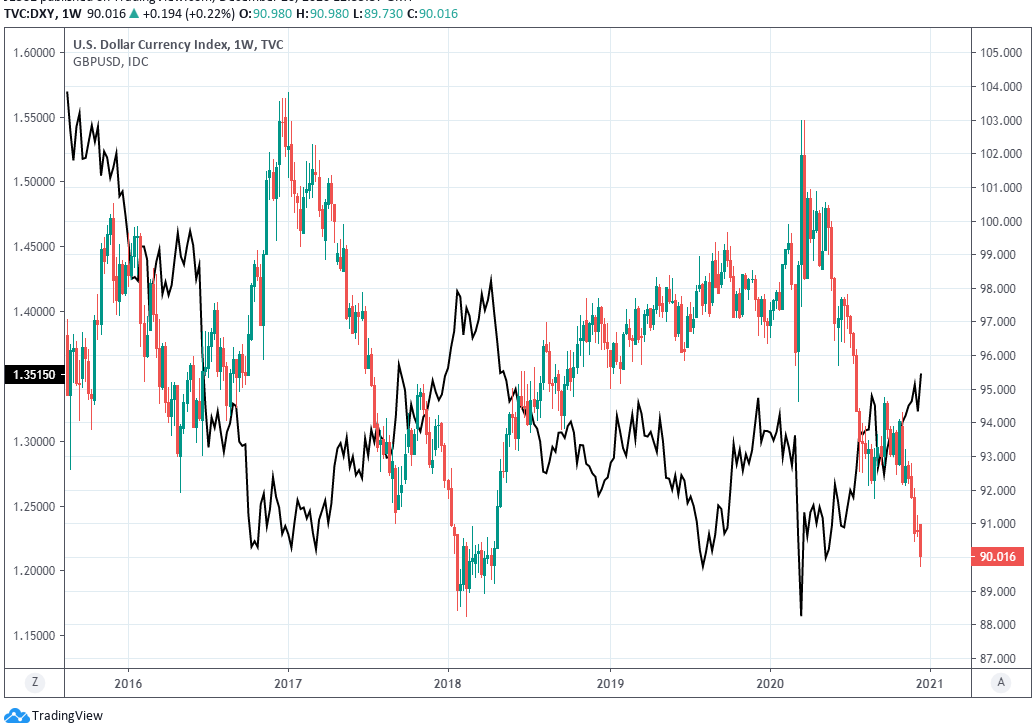Pound-Dollar Week Ahead Forecast: Falling as Brexit Clock Runs Down, New Virus Curtails Recovery
- Written by: James Skinner
- GBP/USD faces festive correction on Brexit & virus risks.
- After being repelled by major, multi-year resistance level.
- Short-term losses could take GBP back to 1.34 & 1.3263.
- Brexit goes to wire as new virus strain threatens recovery.

Image © Adobe Images
- GBP/USD spot rate at time of writing: 1.3515
- Bank transfer rate (indicative guide): 1.3149-1.3243
- FX specialist providers (indicative guide): 1.3319-1.3427
- More information on FX specialist rates here
The Pound-to-Dollar exchange rate ended the week near to early-2018 highs that could be washed away in a correction lower over the coming days as the government's response to a new strain of coronavirus looms large over the economic outlook and as the Brexit clock runs down.
Sterling suffered in pre-weekend profit-taking on Friday, making it the worst performing major currency for the session, although it still remained the third best performer for the week after being lifted by earlier signs that a Brexit trade agreement was all but ratified.
But the Pound will be vulnerable from the open on Sunday after Prime Minister Boris Johnson returned much of England to a state of 'lockdown,' citing a new and more infectious strain of coronavirus that has come as curveball for the economy and optimists who'd hoped that a vaccine rollout could underwrite a robust recovery in 2021.
"It’s going to be very difficult to keep it under control until the vaccine’s rolled out," says Health Secretary Matt Hancock in an interview with Sky News. "We've got a long way to go to sort this. Essentially, we've got to get that vaccine rolled out to get people safe...All of the different measures we have in place, we need more of them to control the spread of the new variant than we did to control the spread of the old variant. That is the fundamental problem."
Above: Pound Sterling performance against major currencies for the week after falling against all major rivals on Friday.
Government officials say they're urgently seeking to understand the mortality rate that comes with the new variant of the disease as well as whether it will respond to the various coronavirus vaccines expected to be rolled out in the months ahead. But the rub for Sterling is that even if the novel immunisations are suitable for the new variant, businesses and the economy could still face months of previously-unanticipated torture at the hands of the government.
"We expect almost all of the highly vulnerable population to have been vaccinated by Q1-2021, and perhaps as much as half the population by summer, reinforcing the UK's recovery from the pandemic," says Sanjay Raja, an economist at Deutsche Bank in a recent note. "It won't be a smooth ride. To be sure, continued (or perhaps even more) monetary and fiscal support will be needed to get the economy firing back on all cylinders. Brexit and lingering restrictions should slow the UK's recovery in Q1-2021."
Thus-far failed attempts at containing the virus are set to continue and if it emerges the new variant cannot be addressed with existing vaccines then it could become more than just a short-term problem for Sterling. The Pound and UK economy join many of their European and North American counterparts in a renewed state of 'lockdown' this week, although Sterling will also have to contend with another threat from the government to pursue a 'no deal' Brexit.
"The latest uptick modestly recalibrates our expectations of what a knee-jerk reaction to a positive deal outcome to look like. Here, we think we could see a push above 1.3712, but cable could begin to see interest to fade an announcement arise between 1.3750 and 1.38. In any case, we think sterling will be a sell in the wake of any announcement, as the pound faces shaky fundamental underpinning," says Jacqui Douglas, chief European macro strategist at TD Securities.
Above: Pound-to-Dollar rate with Fibonacci retracements of September's extension higher and key moving-averages.
"Negative divergence can be spotted on the daily RSI. This points to consolidation," says Axel Rudolph, a senior technical analyst at Commerzbank. "Minor support sits between the 1.3483 September high and the 1.3479 December 9 high. Immediate upside pressure should be maintained while the cross remains above its current December low at 1.3135, though."
Time is running short with barely a fortnight left to ratify any agreement, so the Pound would likely have been vulnerable this week even without suggestions from the government that in the absence of progress, it'll make a Christmas day decision on whether discussions should continue beyond then.
{wbamp-hide start}{wbamp-hide end}{wbamp-show start}{wbamp-show end}
"Fading hopes for a deal after the early week optimism leaves the GBP well off Thursday’s high and flirting with the 1.35 line. Shorter tenor GBP vols are creeping up again as markets prep for more uncertainty running into the end of the year," says Shaun Osborne, chief FX strategist at Scotiabank. "Losses below 1.3450 in the next day or so will point to more sustained weakness."
If a deal is to be agreed at all, it could be the case that it won't happen without the clock first having been run down further. If not for any other reason, because Prime Minister Boris Johnson may feel compelled to minimise the length of time that Conservative Party MPs have available to scrutinise his proposals, certainly if he's made meaningful giveaways in the name of compromise. With four days thought to be the minimum necessary to pass a bill through parliament and the transition set to expire on December 31, negotiators would risk running out of time if something isn't agreed by Friday and the Pound would likely weaken progressively the longer that a deal remains elusive.
Above: Pound-to-Dollar rate at weekly intervals with Fibonacci retracements of referendum fall and key moving-averages.
"In our view, the probability of a deal is 50-50," says Jakob Ekholdt Christensen, chief analyst at Dankse Bank. "No deal would have large negative implications for the UK economy and the GBP, while Europe and, in particular, the global economy would feel less of an impact."
Pound-to-Dollar rate weakness could potentially be exacerbated over the coming days by thin volumes in quiet holiday markets, which may curb risk appetite and encourage a further stabilisation of the U.S. Dollar. Dollars have been sold widely and heavily this year, making for high single digit losses against many currencies, although central banks outside of the U.S. are beginning to complain about currency strength in increasing number and this could become a constraint on some currencies up ahead.
"Interest rate differentials are the USD’s Achilles heel, and they are likely to remain decidedly less favourable," says Richard Franulovich, head of FX strategy at Westpac. "Sustained Fed accommodation, a less combative US-China trading relationship, near 10% GDP growth for China in 2021 and a distinct lack of political uncertainties on the 2021 calendar should continue to drag DXY lower into 2021. DXY is limping into year’s end and likely continues to trade on the back foot toward 88 in Q1."
Investors remain bearish in their Dollar views but with other currencies including Sterling, the Euro, Canadian Dollar et al having reached new two-year highs in recent weeks, the market is ripe for a consolidation into year-end and potentially even some corrective moves lower for the greenback's rivals.
"We think the USD short trade is beginning to look increasingly crowded," says Mark McCormick, global head of FX strategy at TD Securities. "Brexit, Covid and US fiscal developments will remain on the market's radar, as a number of emerging market central banks hold policy meetings in the upcoming week."
Above: U.S. Dollar Index shown at weekly intervals alongside Pound-to-Dollar rate (black line, left axis).








